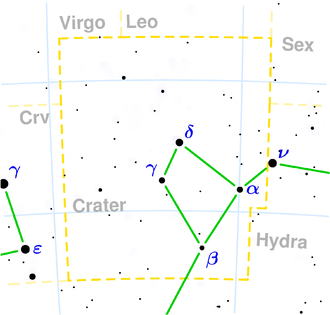NGC 3688
| Galaxie NGC 3688 | |
|---|---|
 | |
| SDSS-Aufnahme | |
| AladinLite | |
| Sternbild | Becher |
| Position Äquinoktium: J2000.0, Epoche: J2000.0 | |
| Rektaszension | 11h 27m 44,4s[1] |
| Deklination | -09° 09′ 56″[1] |
| Erscheinungsbild | |
| Morphologischer Typ | (R')SB(rs)b[1] |
| Helligkeit (visuell) | 14,3 mag[2] |
| Helligkeit (B-Band) | 15,1 mag[2] |
| Winkelausdehnung | 1,2′ × 0,9′[2] |
| Positionswinkel | 20°[2] |
| Flächenhelligkeit | 14,2 mag/arcmin²[2] |
| Physikalische Daten | |
| Rotverschiebung | 0.022115 ± 0.000097[1] |
| Radialgeschwindigkeit | 6630 ± 29 km/s[1] |
| Hubbledistanz vrad / H0 | (290 ± 20) · 106 Lj (88,8 ± 6,2) Mpc [1] |
| Geschichte | |
| Entdeckung | Andrew A. Common |
| Entdeckungsdatum | 1880 |
| Katalogbezeichnungen | |
| NGC 3688 • PGC 35269 • MCG -01-29-024 • IRAS F11252-0853 • KUG 1125-088 • 2MASX J11274443-0909560 • GALEXASC J112744.38-090954.5 • USGC S169 NED05 | |
NGC 3688 ist eine Spiralgalaxie vom Hubble-Typ Sb[2] im Sternbild Becher am Südsternhimmel. Sie ist schätzungsweise 290 Millionen Lichtjahre von der Milchstraße entfernt und hat einen Durchmesser von etwa 100.000 Lichtjahren.
Im selben Himmelsareal befinden sich u. a. die Galaxien NGC 3672, NGC 3702, NGC 3703.
Das Objekt wurde im Jahr 1880 von Andrew Ainslie Common entdeckt.[3]
Weblinks
Einzelnachweise
Auf dieser Seite verwendete Medien
Autor/Urheber: Sloan Digital Sky Survey, Lizenz: CC BY 4.0
The sky image is obtained by Sloan Digital Sky Survey, DR14 with SciServer.
Angle of view: 4' × 4' (0.3" per pixel), north is up.
Details on the image processing pipeline: https://www.sdss.org/dr14/imaging/jpg-images-on-skyserver/



